These Passover pancakes are extremely fluffy and so good, they are arguably better than regular pancakes. Serve alone, with your favorite toppings, or covered in syrup.
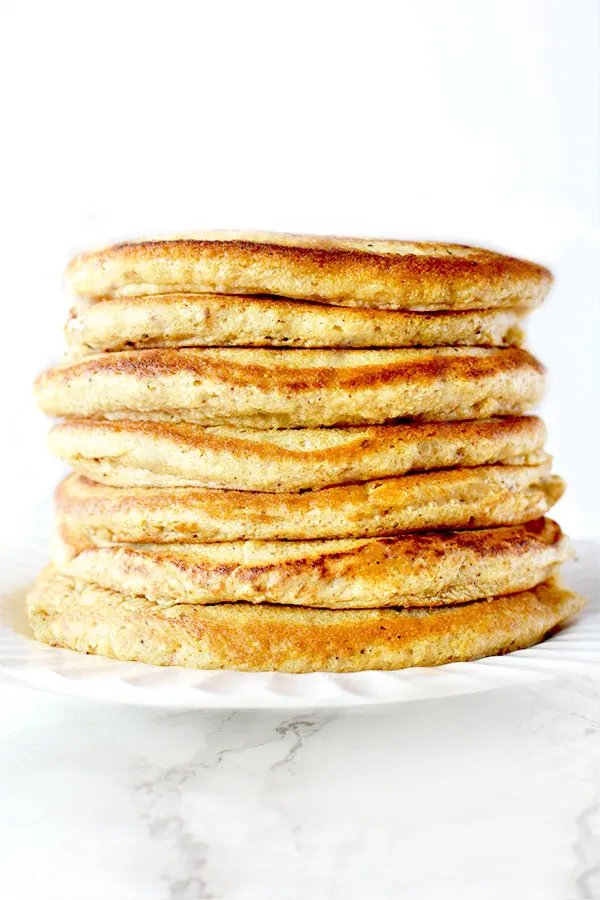
If you’re not new to my blog, you may already know that my family is really big on pancakes.
We love all kinds of pancakes including chocolate chip pancakes, banana pancake, banana chocolate chip pancakes, chocolate pancakes, sour milk pancakes, and sourdough pancakes.
So when Passover comes around, guess what is on our breakfast menu? You got it.
Now let’s talk pancakes.
What makes a good pancake? A pancake must be fluffy. It must also have a touch of sweetness, but not be too sweet that toppings can’t be added.
It also can’t be so thin that it is like a crepe or so thick that you can’t enjoy it.
Well, let me tell you, this Passover pancake has it all.
Say what you will about Passover food – and if you don’t eat kitnyot there isn’t much good to say – but these pancakes are good.
They are some of the lightest and fluffiest I’ve ever tasted!
One of my brothers even said he prefers them to regular pancakes which may be taking it a little far… but to each their own.
By the way, if you like these pancakes, check out these Passover Chocolate Crepes!
CAN YOU USE BAKING POWDER ON PASSOVER?
Absolutely! As long as the box is marked kosher for Passover with a “P” next to the kosher symbol.
I get this question a lot because of the fact that it is a leavener.
The truth is though, while laws regarding Passover are complex, the focus is on wheat flour rather than the leavener itself.
In fact, there wasn’t anything to leaven bread in ancient times except wild yeast.
So, the bread they were making was something of a sour dough bread.
This is the reason it took so long to rise.
HOW TO MEASURE FLOUR AND OTHER DRY INGREDIENTS
The best way to measure dry ingredients is with a scale. However, this is not commonly done in the United States, where dry measuring cups are used instead.
To measure most dry ingredients, first spoon them into a dry measuring cup and then level off the measuring cup with an upside-down butter knife.
Make sure not to pack it down because it can lead to using more of the ingredient than called for.
The exception is brown sugar. To measure brown sugar, pack it into the measuring cup and then level off any excess.
To measure chocolate chips, nuts, or dried fruit, just pour them in and then level them off.
DRY VS LIQUID MEASURING CUP
Dry measuring cups are a set of cups that often come with measuring spoons. Each cup is a different measurement just like each spoon is a different measurement.
Liquid measuring cups, on the other hand, are cups that have measuring lines on the side to mark the measurements.
The problem with using liquid measuring cups to measure dry ingredients (like flour and cocoa) is that they are powders. So, as you shake the cup to level them off, the powders settle and you end up with more than you need.
I tested this with a friend who didn’t believe me and we ended up with a number of tablespoons more than the recipe called for.
WHY sift Powdery Ingredients
There are a number of benefits to sifting powdery ingredients like flour and cocoa.
First of all, flour is often sifted before use to aerate it and remove any lumps. This helps in achieving a lighter texture in baked goods.
Secondly, if you measure flour that’s just been sifted, you can get a more accurate measurement than from flour that’s been packed tightly in a bag.
In addition, sifting dry ingredients together, such as flour, cocoa, and baking powder, helps make sure they’re evenly dispersed.
WHICH TYPE OF OIL TO USE
I use neutral oils. However, if preferred, a stronger flavored one, like coconut oil, can be used.
Sugar
The primary role of sugar is to be a sweetener. However, sugar also contributes to the tenderness and moistness of the baked good by absorbing and retaining moisture and helps create the golden brown color when baking as it caramelizes.
Recipes with more sugar often result in softer, moister textures. However, I learned the hard way that too much sugar leads to a sticky mess.
When it’s heated, sugar caramelizes, resulting in a rich, complex flavor and a brown color. This adds both flavor and color to baked goods and is also the process in which caramel sauce, dulce de leche, caramel candies, and regular candies are made.
When used in recipes containing yeast, the sugar is eaten by the yeast, producing carbon dioxide and causing the dough to rise.
Sugar also acts as a preservative in jams, jellies, and fruit preserves by reducing water activity and preventing microbial growth.
There are many different types of sugar, including white sugar, brown sugar, vanilla sugar, powdered sugar, turbinado sugar, and demerara sugar.
When a recipe calls for “sugar” without specifying anything else, it’s referring to regular white sugar.
White Sugar
White sugar (sometimes called granulated sugar, table sugar, or white granulated sugar) is made of either beet sugar or cane sugar, which has undergone a refining process.
It is the easiest to find and most commonly used.
Brown Sugar
Brown sugar is white sugar with molasses added to it.
It is commonly used in chocolate chip cookie recipes, and it’s rare for a recipe that calls for brown sugar not to also call for white sugar as well.
When a recipe calls for “brown sugar” but doesn’t specify what type (light or dark), it is referring to light brown sugar.
In my recipes, you can use whatever type of brown sugar you have on hand, whether it is dark brown sugar, light brown sugar, or demerara sugar – which is very common in Israel.
Just keep in mind that the flavor and color will be slightly different, depending on what you choose to use.
Turbinado Sugar
Turbinado sugar is better known as “raw sugar.” But, despite this name, the sugar is not really “raw.”
Instead, it’s partially refined sugar that retains some of the original molasses.
The term “raw sugar” may also give off the impression that it is somehow healthier.
In reality, turbinado sugar is nutritionally similar to white sugar.
Demerara Sugar
Demerara sugar is very popular in Israel and is especially delicious in tea, but is also used for baking.
Unlike white sugar, demerara sugar undergoes minimal processing and retains some vitamins and minerals.
However, it is still not much healthier than white sugar.
Vanilla Sugar
Vanilla sugar is not very common in the States. However, it is common in Israel and parts of Europe.
This is sugar that sat for an extended period of time with vanilla beans, giving it a vanilla flavor.
Caster Sugar
This type of sugar is common in the United Kingdom.
It has a grain finer than white (granulated) sugar and larger than powdered sugar.
Caster sugar is often called for in recipes for delicate baked goods like meringues, souffles, and sponge cakes.
You can use a 1:1 conversion rate between caster sugar and white (granulated) sugar.
Powdered sugar
Powdered sugar, sometimes known as confectioners’ sugar, is a sugar with a powdered texture.
This sugar is rarely used for baking. Instead, it is used for dusting desserts and making frosting, icing, and glazes.
In some countries, you can also find powdered vanilla sugar.
It is made the exact same way regular vanilla sugar is made. However, the sugar used is powdered instead of granulated.
Vanilla Extract vs Vanilla sugar
In my recipes, I don’t specify what kind of vanilla to use.
The reason for this is that in the States, vanilla extract is exclusively used.
Meanwhile in Israel, along with many European countries, vanilla sugar is common.
In most, if not all recipes, both vanilla extract and vanilla sugar can be used.
In recipes where vanilla sugar can be used instead of extract, you can replace them 1:1.
Replacing Sugar with Honey
If you’d prefer to use honey instead of sugar, you can do so with pretty good results.
Honey can be two or even three times as sweet depending on the honey, so for every 1 cup of sugar, you can use 1/2 to 2/3 cup honey.
Since honey adds liquid, you need to remove some to balance it out. For every cup of honey, remove a 1/4 cup of liquid.
Also, it burns faster than granulated sugar, so you want to lower the baking temperature by 25 F. In addition, check it early and often to avoid burning or overbaking.
How to Store Sugar
Sugar should be stored in an airtight container to prevent clumping and moisture absorption, and kept in a cool, dry place.
DO EGGS NEED TO BE AT ROOM TEMPERATURE?
The short answer is “no.” While a side-by-side comparison shows that baking with eggs at room temperature makes a better crumb, it’s not otherwise noticeable.
What are Eggs used for?
Eggs do three things in most recipes: they help bind the ingredients together, act as a mild leavening agent, and they add moisture.
ARE EGGS DAIRY?
No, eggs are not dairy. Dairy is milk and any food products made from milk, including cheese, cream, butter, and yogurt.
So, while eggs are an animal product, they are not dairy. In fact, eggs fall under the protein food group.
How to tell if your eggs are still good
Fill a glass with cool water and submerge the eggs.
If the eggs sink to the bottom and lay flat on their side, they’re still fresh.
If they sink, but stand on one end at the bottom of the glass, the eggs are not as fresh but still good.
An egg that floats to the top is likely spoiled.
EGGLESS OPTION
Eggs can be substituted with 1/4 cup of unsweetened apple sauce per egg. This means that for recipes calling for 2 eggs, you’d need 1/2 cup of unsweetened apple sauce.
The reason applesauce makes a good binder is that it’s high in pectin. Pectin is a naturally occurring starch in fruits and berries that acts as a thickening agent and stabilizer in food.
This happens when combined with sugar and acid (if the fruit or berry isn’t naturally acidic).
Just keep in mind that it may change the flavor slightly.
Can I use Baking Soda Instead?
I always recommend following a recipe as it is written. However, if you only have baking soda on hand, you can use 1 to 1 1/2 teaspoon of baking soda.
BAKING SODA VS BAKING POWDER
Both baking soda and baking powder are leavening agents, which means that they help baked goods rise. However, they’re not the same thing and they are not interchangeable.
Using baking soda instead of baking powder can give your recipe a terrible metallic taste, while using baking powder instead of baking soda leaves your baked goods looking flat.
BAKING SODA
When baking soda (also known as sodium bicarbonate) is combined with acidic ingredients and exposed to heat, it causes batter or dough rise and contributes to their light and fluffy texture.
However, baking soda is a versatile ingredient. It can be sprinkled over meat to tenderize it and it can be added to tomato sauce to neutralize the acidity.
Baking soda, when combined with an acid – such as cream of tartar, lemon juice, buttermilk, cocoa, and vinegar – creates carbon dioxide. When the carbon dioxide is released, it causes the familiar texture and crumb in pancakes, cakes, quick breads, soda bread, and other baked and fried foods.
A good rule of thumb is to use around 1/4 teaspoon of baking soda per 1 cup of flour.
BAKING POWDER
Baking powder is created by combining baking soda, cream of tartar, and sometimes cornstarch.
Since baking powder already contains an acid, it’s most often used when a recipe does not call for an additional acidic ingredient or calls for too little of one.
There are two types of baking powder. Single-acting baking powder and double-acting baking power.
Single-acting baking powder gets activated only once – when it gets wet.
Most baking powder sold is double-acting. This means that the leavening occurs in two steps.
The first is when the baking powder gets wet, which is why you cannot prepare some batters ahead of time to bake later. The second step is when the baking powder is exposed to heat, which happens when the batter is baked or fried.
A good rule of thumb is to use around 1 teaspoon of baking powder per 1 cup of flour.
WHY SOME RECIPES CALL FOR BOTH
Some recipes use both baking soda and baking powder because they need extra leavening that the baking soda alone cannot provide.
In these cases, baking soda provides an initial lift, while baking powder provides additional rise.
WHICH ONE IS STRONGER?
You may have already guessed the answer since baking soda is used to make baking powder and you need more baking powder per cup of flour. But I’ll tell you anyway.
Baking soda is four times stronger than baking powder.
That’s why you will, more often than not, see recipes that only call for baking soda rather than recipes that only call for baking powder.
HOW LONG DO THEY LAST?
BAKING SODA
Baking soda is good indefinitely past its best by date, although it can lose potency over time.
A good rule of thumb is two years for an unopened package and six months for an opened package.
However, to be honest, I’ve used very old baking soda with good results.
BAKING POWDER
Like baking soda, baking powder is good indefinitely past its best by date, and can lose its potency over time.
For both opened and unopened, it’s ideal to use it within nine months to a year.
While storing it, make sure to keep it in a dry place and away from humidity.
HOW TO TEST IF IT’S STILL GOOD
BAKING POWDER
To test baking powder, pour 3 tablespoons of warm water into a small bowl, add 1/2 teaspoon of baking powder, and stir.
If the baking powder is good to use, it should fizz a little.
BAKING SODA
To test baking soda, pour 3 tablespoons of white distilled vinegar into a small bowl, add 1/2 teaspoon of baking soda, and stir.
The mixture should rapidly bubble if the soda is fresh.
Can I Double this recipe?
Only if you make a single batch two times.
My mom tried doubling it (she hates to cook so she doubles everything to avoid doing it a second time) and it didn’t work out well.
Passover Pancake Tip:
I recommend spraying the pan with oil before each pancake.
Spray oil gives a light coating so it’s not too oily, and spraying before each one makes it easier to flip.
Snafu
We made the batter and then got busy doing other things. This quickly turned into a very thick batter.
To fix this, we added water as needed until we got the right consistency.
It still tasted good, but I felt it was better when we didn’t do this. Though, honestly, that my have been my imagination.
Passover Pancakes
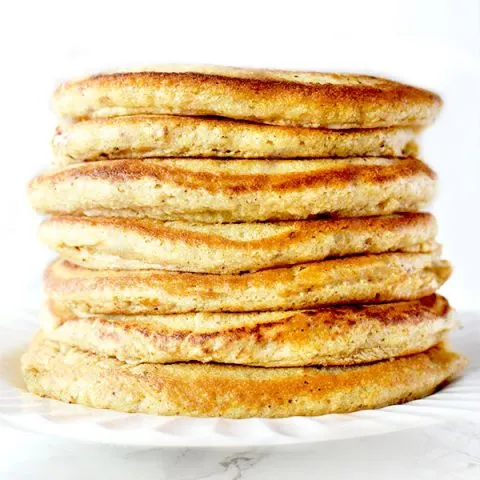
Incredibly moist and fluffy pancakes that are kosher for Passover.
Ingredients
- 1 1/4 cups matzo meal (160 grams)
- 1/2 cup potato starch (75 grams)
- 1 1/2 tablespoon baking powder
- 1/2 cup white sugar
- 1/2 teaspoon salt
- 4 eggs
- 1 cup water (120 milliliters)
- 2 tablespoons oil
Instructions
- Whisk together matzo meal, potato starch, sugar, baking powder, and salt in a mixing bowl.
- Add eggs and water. Mix well.
- Lightly coat a small frying pan or a griddle pan with oil. Lower to a medium low flame.
- Using a ladle, pour in the batter. Cook on one side until bubbles form. Flip and cook for about another minute.
- (If the batter begins to thicken, add a little water at a time to thin it out - up to 1/2 cup.)
- Remove and repeat with the remaining batter.
Notes
If you let the batter sit for 10 minutes, you will get denser pancakes.
If you do not let the batter sit but notice it getting thicker as you make them, add a little liquid until you get the desired consistency.
Recommended Products
Some of the links below are affiliate links, which means that if you choose to make a purchase, I will earn a small commission. This commission comes at no additional cost to you.
Nutrition Information:
Yield:
6Serving Size:
1Amount Per Serving: Calories: 399Total Fat: 9gSaturated Fat: 1gTrans Fat: 0gUnsaturated Fat: 6gCholesterol: 124mgSodium: 599mgCarbohydrates: 71gFiber: 2gSugar: 17gProtein: 10g
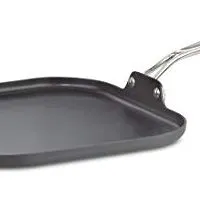
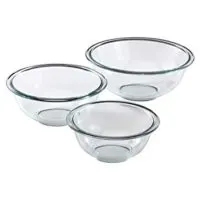
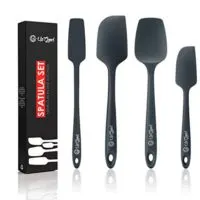
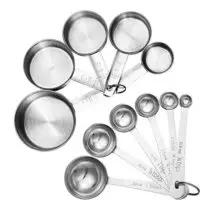
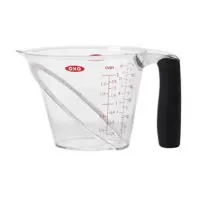
Galit
Monday 15th of April 2024
Hi. Thank you for the recipe. Can you use milk instead of water and almond flour instead of potato starch?
ElissaBeth
Thursday 18th of April 2024
You can use milk instead of water but I never tried almond flour instead of potato starch. If you try it please let me know how it works :)
Amy
Tuesday 11th of April 2023
Did you mean matzah cake meal? Mine came out waaaay too thick. I watered down the next batch and they still weren't pancakey. Had to toss all of them as my kids wouldn't eat them.
ElissaBeth
Thursday 13th of April 2023
No, it is regular matzah meal. However, it seems to me that sometimes it comes out thicker than other times. When this happens it's best to add more water as needed.
Wafflemonster
Friday 7th of April 2023
I followed the recipe and I needed to add more than double the liquid for the amount of dry ingredients. So I had a lot more pancakes, not a bad thing - and they went down a treat. Curious why i had such a different result to everyone else. Maybe my scale is on the blink
ElissaBeth
Thursday 13th of April 2023
I have noticed myself that sometimes I need more liquid and it's rarely the same amount. I suspect it has something to do with humidity levels because I know that can happen with flour.
Vale
Wednesday 27th of April 2022
Hello! These pancakes are exceptional, I agree with your brother! I achieved the perfect consistency and fluffiness, which is a first for me… and the taste is divine. I would like to recycle the recipe for the rest of the year; do you know if I can just substitute the matzah flour with regular flour? Thank you!
ElissaBeth
Monday 2nd of May 2022
I'm glad to hear that you enjoyed them so much! I've never tried it but I doubt it is a 1:1 conversion from matzah flour to all purpose flour. I really like my year-round pancakes though so you may enjoy those as well :)
Scott
Saturday 23rd of April 2022
Thank you for the recipe; I made it today with some modifications--some practical, some personal.
For convenience, I cut the recipe in half--thanks again for the measures by weight, BTW. I didn't have potato starch and didn't think the potato flour I had would be a good sub, but I did have tapioca starch left from a recent recipe, and from what I've been reading that's a perfectly fine 1:1 substitute.
Those were the practical changes. I also reduced the sugar, since I don't have much of a sweet tooth; the halved version is 1/4 cup (4 tablespoons), so I went with 3T. Also, at the last minute I decided to make them into waffles rather than pancakes. I like waffles better than pancakes, and I saw the comments noting how thick the batter was, especially after sitting, and thick batter is perfect for a waffle maker. I also added some vanilla.
It came out very nicely, making two waffles in my Belgian-style waffle maker (a Calphalon No Peek Waffle Maker that has never needed oiling and has worked perfectly for more years than I can count). Still a little sweet for my taste--I'd do it again with more than 2T sugar (1/4c in the original quantity) and probably just 1 T. I'd also try with some diced fresh apple mixed in and some cinnamon and nutmeg.